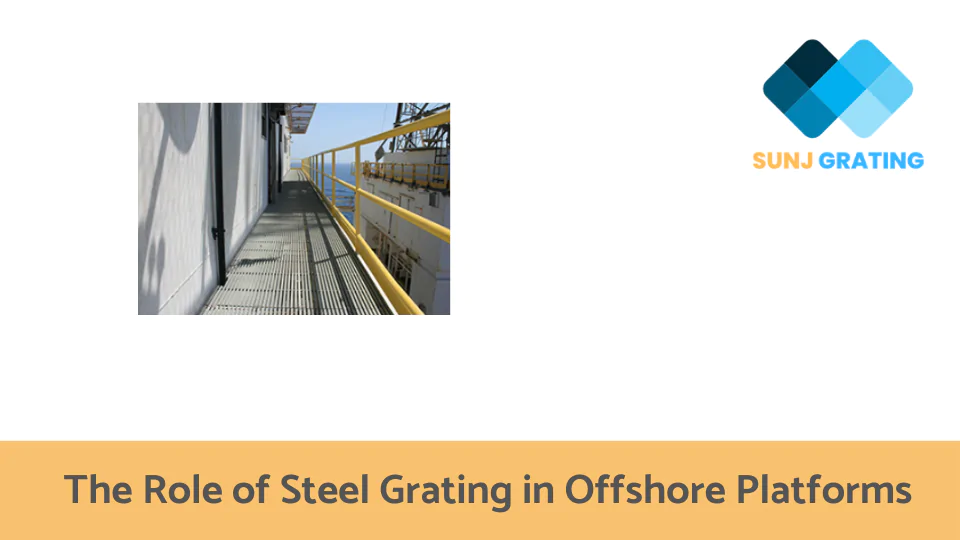Have you ever wondered how offshore platforms, those colossal structures in the middle of the ocean, manage to withstand the relentless forces of nature? What keeps them sturdy and safe for workers amidst the pounding waves, aggressive winds, and corrosive saltwater? The answer lies in the materials used, and one unsung hero in this context is steel grating.
Steel grating plays a pivotal role in ensuring the safety and efficiency of offshore platforms. These robust grids provide the necessary support and surface for walkways, drainage systems, and protective screens. Their durability and strength are unmatched, making them an indispensable component in the challenging offshore environment.
By the end of this article, you’ll appreciate the significance of steel grating and understand why it’s a top choice for offshore platform construction. Dive in and discover the world of steel grating’s contribution to the energy sector.
What is Steel Grating?

Steel grating is a versatile construction material made up of a series of bearing bars and cross rods. These bars and rods are welded or locked together at their intersections, forming a grid-like pattern. Typically made from carbon steel, stainless steel, or aluminum, these gratings are designed to bear heavy loads and provide a safe walking surface.
The key characteristics of steel grating that make it stand out include
| Durability | Steel grating is known for its long lifespan. When properly treated, it can resist wear and tear, even in the most demanding conditions. |
| Strength | Its robust construction allows it to support heavy equipment, machinery, and foot traffic without buckling or breaking. |
| Corrosion Resistance | Especially when galvanized or made from stainless steel, these gratings can resist the harmful effects of elements like saltwater, making them ideal for marine environments. |
The Importance of Durability and Strength in Offshore Environments
Offshore platforms are subjected to some of the harshest conditions on the planet. They face constant exposure to saltwater, which is corrosive. They must endure the relentless pounding of waves, the force of strong winds, and the immense weight of equipment and machinery.
Given these challenging conditions, the materials used in the construction of offshore platforms need to be exceptionally resilient. They must not only support the weight and operations of the platform but also resist the corrosive and erosive effects of the marine environment. Materials that deteriorate quickly can compromise the safety of the platform, leading to potential accidents, costly repairs, and operational downtimes.
Specific Uses of Steel Grating in Offshore Platforms

Walkways and Platforms: One of the primary uses of steel grating in offshore platforms is for walkways and platforms. These gratings provide a stable and slip-resistant surface, ensuring that workers can move around safely, even in wet conditions. The open design also allows for easy cleaning and prevents the accumulation of debris.
Drainage Systems: Steel grating is crucial in drainage systems on offshore platforms. Its open grid design ensures that water, whether from rain or waves, can flow through easily. This prevents pooling of water, which can be a hazard in such environments.
Protection Screens: These are used to shield vital equipment from environmental elements like wind and water spray. Steel grating ensures that the equipment is protected while still allowing for ventilation and easy access for maintenance.
Stair Treads: In high-traffic areas, especially stairs, safety is paramount. Steel grating stair treads provide the necessary grip, ensuring that workers can ascend and descend without the risk of slipping, even in wet or oily conditions.
Advantages of Using Steel Grating in Offshore Settings

Corrosion Resistance
One of the standout features of steel grating, especially when it’s galvanized, is its ability to resist the corrosive effects of saltwater. The galvanization process coats the steel with a protective layer of zinc, which acts as a barrier against rust and corrosion, making it ideal for marine environments.
Maintenance and Longevity
Steel grating requires minimal maintenance. Its robust nature means fewer replacements or repairs, translating to significant cost savings over the platform’s lifespan. This durability ensures that offshore platforms can operate efficiently without frequent downtimes for maintenance.
Flexibility in Design
Steel grating can be tailored to fit various areas and needs of an offshore platform. Whether it’s for walkways, protective screens, or drainage systems, its design can be customized to meet specific requirements, ensuring optimal functionality.
Safety Enhancements
Beyond its structural advantages, steel grating offers safety features like anti-slip surfaces. The grid pattern provides grip, reducing the risk of accidents, especially in wet or oily conditions typical of offshore settings.
Comparing Steel Grating with Other Materials
| Feature/Property | Steel Grating | Wooden Planks | Concrete |
| Durability | High | Moderate | High |
| Strength | High | Moderate | High |
| Corrosion Resistance | High | Low | Moderate |
| Maintenance | Low | High | Moderate |
| Flexibility in Design | High | Low | Low |
| Safety Features | High | Moderate | Moderate |
Environmental Considerations
Steel grating scores high on the sustainability front. Its recyclability ensures that old or discarded gratings don’t end up as waste but can be melted down and repurposed. This reduces the need for new raw materials, conserving resources, and reducing environmental impact. Additionally, the long lifespan of steel grating means less frequent replacements, further reducing its environmental footprint.
However, like all industrial processes, the production of steel grating can have environmental impacts. These concerns are mitigated through modern manufacturing practices, efficient resource use, and adherence to environmental regulations. The industry continually seeks ways to reduce emissions and waste during production.
Conclusion
Steel grating stands as an unsung hero in the world of offshore platforms. Its durability, strength, and adaptability make it indispensable in ensuring the safety and efficiency of these marine giants. As we’ve explored, its advantages far outweigh those of alternative materials.
For industries operating in challenging marine environments, prioritizing quality materials like steel grating isn’t just a good decision—it’s a necessity. Embracing such materials ensures not only operational efficiency but also the safety of countless workers who rely on the integrity of these platforms daily.


